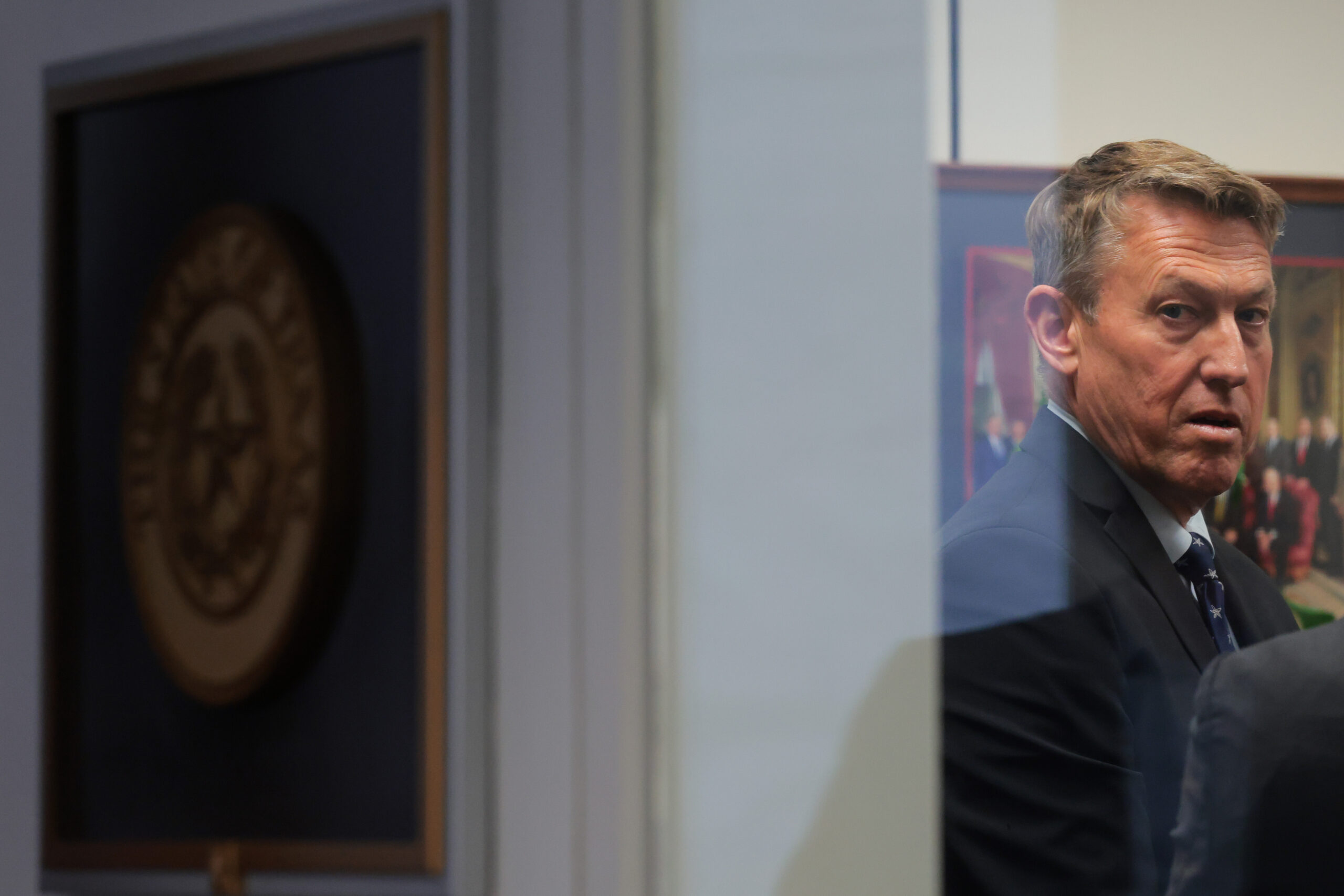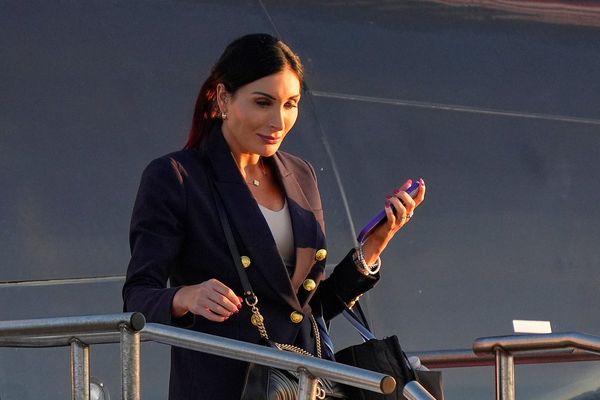
President Donald Trump’s nominee to run Customs and Border Protection has been accused of participating in an alleged agency cover-up after officials killed a man in the process of deporting him in 2010.
The family of Anastasio Hernández Rojas is waiting on a decision from an international human rights tribunal that conducted a yearslong investigation into his killing and alleged torture and subsequent denial of justice.
Sen. Ron Wyden (D-Oregon) sent a letter to the Department of Homeland Security last week asking for documents related to the case in preparation for Wednesday’s confirmation hearing of Rodney Scott, who oversaw a special team that attorneys for the family say helped the officials involved in the 2010 incident escape prosecution.
“I have serious concerns about the gross failures of integrity and leadership he has shown,” Wyden wrote in the letter to Homeland Security Secretary Kristi Noem.
Scott was acting deputy chief patrol agent of the San Diego Border Patrol Sector in 2010 when border officials beat Hernández Rojas and shocked him with a Taser until he stopped breathing. Hernández Rojas died in a hospital days later.
In the aftermath of the killing, a Border Patrol investigative team that Scott oversaw at the time began working the case even though the San Diego Police Department’s homicide team had jurisdiction. Over the years, that Border Patrol team has been accused of covering up and even tampering with evidence both in Hernández Rojas’ case and in other instances of officers or agents using potentially excessive force.
“Given that CBP is the largest law enforcement agency in the country and the least accountable, we should be very concerned about putting someone at the head of that agency whose disregard for abuse of power could endanger the country,” said Andrea Guerrero, executive director of Alliance San Diego and one of the attorneys who represented Hernández Rojas’ family in the international human rights case.
Scott, who served as the head of U.S. Border Patrol during the first Trump administration, did not respond to a request for comment from Capital & Main. The White House also did not respond to a request for comment.
Scott’s association with the Hernández Rojas case isn’t the only part of his past that immigrant rights activists find problematic with his nomination.
For example, Scott was a member of a Border Patrol agent Facebook group that ProPublica found was filled with racist and sexist posts.
He served as deputy chief patrol agent for the San Diego Sector when agents there used effigies of migrants as target practice and used those same effigies to teach children how to shoot guns.
But it is his oversight of Border Patrol’s investigative units that has advocates particularly concerned. It’s not clear whether Scott ever worked on the unit himself, but it is clear that he was in a supervisory position to the team at the time of Hernández Rojas’ death.
Interfering With Justice
To seek justice after the U.S. government decided not to prosecute agents involved in Hernández Rojas’ death, his family members worked with attorneys to submit a case to the Inter-American Commission on Human Rights in 2016. The commission is part of the Organization of American States, of which the U.S. is a member.
It was during the subsequent work to gather evidence for that case that attorneys representing the family discovered that Border Patrol sectors had special investigative units whose role, according to a PowerPoint document from the San Diego Sector, included protecting officials from liability.
Called critical incident teams, critical incident investigative teams, or evidence collection teams, the units responded to what the Border Patrol referred to as critical incidents, or “incident(s) involving CBP personnel that results in a serious injury, a death, a use of deadly or excessive force, or widespread media attention,” according to a Government Accountability Office report.
The teams were homegrown within Border Patrol and were not officially authorized to investigate agent use of force. The Biden administration disbanded them in 2022 after attorneys working on the Hernández Rojas case publicized their existence.
The Inter-American Commission on Human Rights has said that countries are supposed to ensure that the people investigating in-custody deaths are independent both hierarchically and institutionally. Having the Border Patrol investigate its own agents’ wrongdoing falls short of that requirement, but documents in the Hernández Rojas case show that the investigative team’s involvement went beyond a potential conflict of interest.
It all began when, one evening in May 2010, a group of border officials that included members of Border Patrol, Customs and Border Protection, and Immigration and Customs Enforcement beat, kicked, knelt on and used a Taser on Hernández Rojas while he was handcuffed and face down on the ground at the San Ysidro Port of Entry in the walkway that deportees went down to return to Mexico, according to police records. He stopped breathing and was taken to a hospital, where he died three days later.
At the scene, officials allegedly deleted videos from the phones of witnesses, and the Critical Incident Investigative Team began its work. No one contacted the San Diego Police Department until the next day, when a radio journalist called to inquire about the case, according to police records.
“It was such a clusterfuck,” said Ron Newquist, who at the time worked as a homicide investigator for the San Diego Police Department and has since retired from the force. “When the dust had settled, all the witnesses were gone. People who were involved in the physical struggle with Anastasio were gone. People were pointing double fingers in both directions.”
A Border Patrol briefing document that is part of police records from the day after the beating shows that the Border Patrol Critical Incident Investigative Team was “coordinating” the investigation with San Diego police. But the Critical Incident Investigative Team’s report was never given to police, Newquist said.
According to a letter sent by Alliance San Diego to the San Diego District Attorney’s office in 2021 calling for officials involved in the alleged cover-up to be investigated, a copy of the Border Patrol team’s report is under protective seal and contains a version of the arrest report from when a Border Patrol agent apprehended Hernández Rojas crossing the border that is different from what was given to San Diego police. The letter alleges that a section of the arrest report narrative that would contradict the agency’s claims that Hernández Rojas was aggressive prior to the beating was removed.
Whistleblowers who worked in the oversight branch of Customs and Border Protection came forward during the international human rights case to say that an official in the highest ranks of the agency in Washington had tried to spin what happened and had even given orders to falsify reports.
Members of the Border Patrol investigative team were present for interviews with witnesses as well as the autopsy, according to police records. Agents also issued an administrative subpoena for Hernández Rojas’ medical records at the hospital and then declined to give them to San Diego police, citing medical privacy concerns. A briefing filed with the commission by attorneys representing Hernández Rojas says that Scott signed the subpoena since he was in charge of the San Diego Sector at the time.
One of the most glaring pieces of missing evidence for San Diego police is video footage of what happened from government cameras in the area.
“We never got the video we were hoping to get — that you think you would get at the port of entry to the busiest border in the world,” Newquist said. “The [police] report reads like a runaround. I think there’s enough verbiage in there that it speaks for itself.”
In the police report, investigators documented an extensive back-and-forth with Customs and Border Protection and Border Patrol. The police detective said in the report that he learned that Border Patrol had forwarded footage to its investigators, but when an agent later gave a CD of footage to the police detective, it was for the wrong time frame. Officials then punted the detective among agents and officers until eventually he learned that the footage had been written over by new recordings.
“I’m not saying there was a cover-up,” Newquist said. “Maybe it was just incompetence, and they were so sloppy, they were embarrassed. But when you start losing videos, and you don’t get the medical stuff, you could infer what you want.”
The result, according to attorneys representing the family of Hernández Rojas, was a violation of the right of access to justice.
Defending the Agents
It’s not clear whether Scott ever worked on a critical incident team himself, but a questionnaire from a 2019 job posting shows that Customs and Border Protection viewed participation on these teams favorably in the promotion process.
What is clear, attorney Guerrero said, is that Scott supervised the team when he worked in the upper ranks of the San Diego Sector, including during the Hernández Rojas investigation and after.
In 2016, a woman agent filed a lawsuit over a hidden camera that a man agent installed in a women’s bathroom and changing room used by members of the Critical Incident Investigative Team. According to court records, Scott and another supervising agent confronted the man, who was also a member of the investigative team, after a woman agent discovered the camera.
In his time in leadership, Scott showed himself to be quick to defend agent actions, even in questionable circumstances.
In 2012, when Scott was deputy chief of the sector, a San Diego Border Patrol agent shot and killed Valeria Tachiquín, a 32-year-old U.S. citizen and mother, on a residential street in Chula Vista, California.
“It doesn’t matter what I do,” the woman’s father, Valentin Tachiquín, told reporters in 2022. “My daughter won’t ever come back to me and to her children, and it’s very sad.”
Tachiquín was inside a home where agents in plainclothes appeared with a warrant looking for someone else. Tachiquín attempted to leave, and an agent followed her.
Tachiquín ended up dead in her car, her windshield riddled with bullet holes.
Scott, who arrived on the scene while the investigation was ongoing, told reporters that Tachiquín had struck the agent with her car and that the agent shot her in self-defense. But several witnesses, including a U.S. Marine Corps veteran, told local news outlets that they saw the agent standing on the street in front of the car, which was slowly moving in reverse, when he fired his gun.
That was the first time, Guerrero said, that she had seen Border Patrol give a statement at the beginning of an active investigation into one of its agents’ use of force.
Meanwhile, Prince Watson, the veteran who’d witnessed the shooting, told news outlets that Border Patrol agents locked him in their patrol car when he refused to speak with them about what he’d seen. Watson said the agents kept saying that the agent had been hit by the car and was on the hood when he fired his gun, as though trying to get Watson to adopt their version of the story.
“That’s a clear disregard for investigative protocol and an example of how investigations of agents are routinely obstructed,” Guerrero said.
ABC 10News later learned that the agent who shot Tachiquín had previously resigned from the Imperial County Sheriff’s Department after being told he would be fired for misconduct that included lying.
“[Scott] has never been a part of any meaningful attempt at accountability with agents. Every shoot is a ‘good shoot.’ That’s very Border Patrol language,” Guerrero said.
“And a person who can’t recognize abuse of power is a person who shouldn’t hold power,” she added.
Scott’s stance on the border and the agents who work it seem to be closely tied to his religious beliefs. He previously told a KQED journalist that “the first deportation and the first borders were created in Genesis.”
Pedro Rios, director of the American Friends Service Committee’s U.S./Mexico Border Program, recalled a phone conversation with Scott after Border Patrol agents arrested faith leaders protesting mistreatment of migrants by approaching the wall at its westernmost point in December 2018. He said Scott told him the faith leaders’ actions “did not really reflect what a true commitment to God meant.”
In 2020, Scott became chief of Border Patrol nationwide. He retired in August 2021 during the Biden administration after refusing to go along with some of the president’s policy changes, including getting rid of government use of the controversial phrase “illegal alien.”
Scott’s confirmation hearing will be held on April 30.







